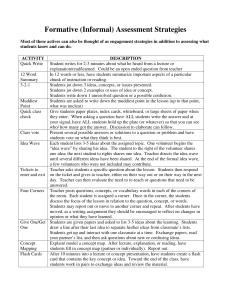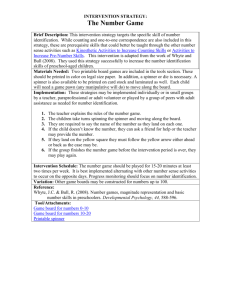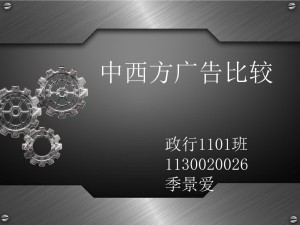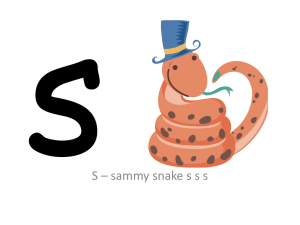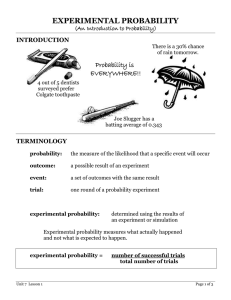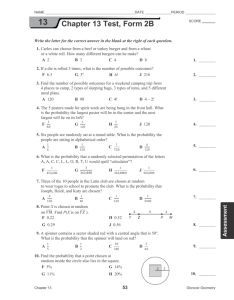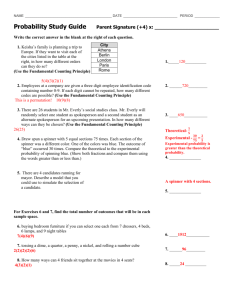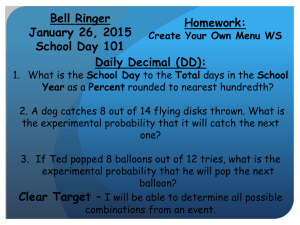Formative Assessment Techniques to Check for Understanding
advertisement
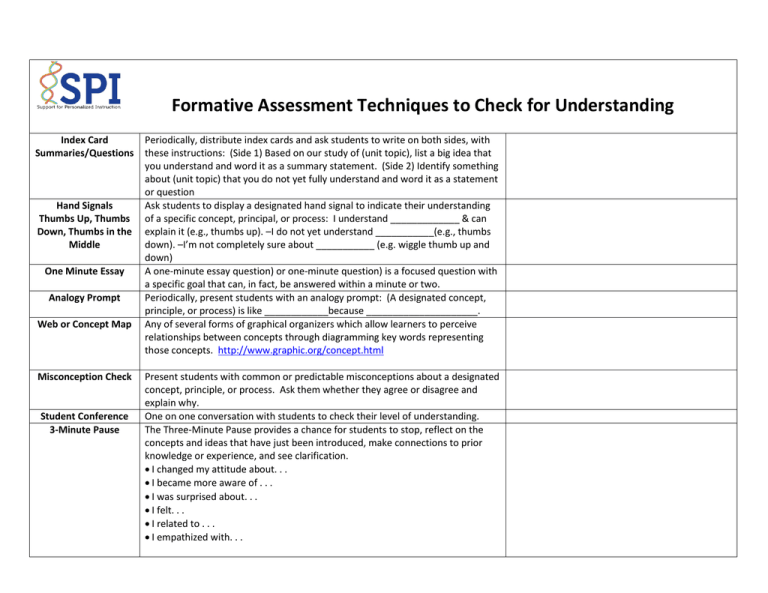
Formative Assessment Techniques to Check for Understanding Index Card Summaries/Questions Hand Signals Thumbs Up, Thumbs Down, Thumbs in the Middle One Minute Essay Analogy Prompt Web or Concept Map Misconception Check Student Conference 3-Minute Pause Periodically, distribute index cards and ask students to write on both sides, with these instructions: (Side 1) Based on our study of (unit topic), list a big idea that you understand and word it as a summary statement. (Side 2) Identify something about (unit topic) that you do not yet fully understand and word it as a statement or question Ask students to display a designated hand signal to indicate their understanding of a specific concept, principal, or process: I understand _____________ & can explain it (e.g., thumbs up). –I do not yet understand ___________(e.g., thumbs down). –I’m not completely sure about ___________ (e.g. wiggle thumb up and down) A one-minute essay question) or one-minute question) is a focused question with a specific goal that can, in fact, be answered within a minute or two. Periodically, present students with an analogy prompt: (A designated concept, principle, or process) is like ____________because _____________________. Any of several forms of graphical organizers which allow learners to perceive relationships between concepts through diagramming key words representing those concepts. http://www.graphic.org/concept.html Present students with common or predictable misconceptions about a designated concept, principle, or process. Ask them whether they agree or disagree and explain why. One on one conversation with students to check their level of understanding. The Three-Minute Pause provides a chance for students to stop, reflect on the concepts and ideas that have just been introduced, make connections to prior knowledge or experience, and see clarification. I changed my attitude about. . . I became more aware of . . . I was surprised about. . . I felt. . . I related to . . . I empathized with. . . Observation Self-Assessment Exit Card Portfolio Check Journal Entry A-B-C Summaries Debriefing Idea Spinner Inside-Outside Circle Numbered Heads Together One Sentence Summary Think-Pair-Share Ticket to Leave Walking around the classroom and observe students as they work to check for learning. Strategies include: Anecdotal Records Conferences Checklists A process in which students collect information about their own learning, analyze what it reveals about their progress toward the indeed learning goals and plan the next steps in their learning. Exit cards are written student responses to questions posed at the end of a class or learning activity or at the end of a day. Check the progress of a student’s portfolio. A portfolio is a purposeful collection of a significant work, carefully selected, dated and presented to tell the story of a student’s achievement or growth in well-defined areas of performance, such as reading, writing, math, etc. A portfolio usually includes personal reflections where the student explains why each piece was chosen and what it shows about his/her growing skills and abilities. Students record in a journal their understanding of the topic, concept or lesson taught. The teacher reviews the entry to see if the student has gained an understanding of the topic, lesson or concept that was taught. Each student in the class is assigned a different letter of the alphabet and they must select a word starting with that letter that is related to the topic being studied. A form of reflection immediately following an activity. The teacher creates a spinner marked into 4 quadrants and labeled “Predict, Explain, Summarize, Evaluate.” After new material is presented, the teacher spins the spinner and asks students to answer a question based on the location of the spinner. For example, if the spinner lands in the “Summarize” quadrant, the teacher might say, “list the key concepts just presented.” Inside and outside circles of students face each other. Within each pair of facing students, students quiz each other with questions they have written. Outside circle moves to create new pairs. Repeat. Each student is assigned a number. Members of a group work together to agree on an answer. The teacher randomly selects one number. Student with that number answers for the group. Students are asked to write a summary sentence that answers the “who, what, where, when, why, how” questions about the topic. Students think individually, then pair (discuss with partner), then share with class. Closing activity where students respond in writing or verbally to short assignments Turn to Your Partner Teacher gives direction to students. Students formulate individual response, and then turn to a partner to share their answers. Teacher calls on several random pairs to share their answers with the class.
